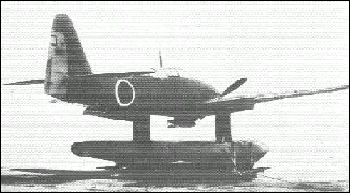M6A Seiran, Japanese
| ![]() The Pacific War Online Encyclopedia | |
| -------------------------------------------------------------------------------- | |
The Pacific War Online Encyclopedia | |
| -------------------------------------------------------------------------------- | |

U.S. Navy. Via Wikipedia Commons
Aichi M6A Seiran ("Mountain Haze")
| Crew | Two in tandem cockpit |
|---|---|
| Dimensions | 40'3" by 38'2" by 15'0"12.26m by 11.64m by 4.58m |
| Wing area | 291 square feet27 square meters |
| Weight | 7277-9800 lbs3301-4445 kg |
| Speed | 295 mph at 17,060 feet475 km/h at 5200 meters |
| Cruising speed | 184 mph at 9.845 feet296 km/h at 3000 meters |
| Climb rate | 28 feet per second8.6 meters per second |
| Ceiling | 32,480 feet9900 meters |
| Power plant | One 1400hp (1044 kW) Aichi AE1P Atsuta30 12-cylinder inverted-V liquid cooled engine driving a constant speed three-blade metal propeller. |
| Armament | One flexible 13mm Type 2 machine gun in the rear cockpit |
| Bomb load | 2 250 kg (551 lb) bombs or 1 850 kg (1874 lb) bomb or 1 800 kg (1760 lb) torpedo |
| Range | 642 nautical miles (1190 km) |
| Production | A total of 28 A6Ms were built at Aichi Kokuki K.K., Eitoku: 6 M6A1 prototypes (1943-10 to 1944-10) 20 M6A1 production aircraft (1944-10 to 1945-7) 2 M6A1-K trainerprototypes (1945) |
| Variants | The M6A1-K was a trainer with retractable landing gear. |
The M6A Seiran was built specifically for use on the Sen-toku class aircraft carrying submarines. The original specifications called for a fast aircraft without an undercarriage, but the design was revised to use twin detachable floats. The wings and tail surfaces could be tightly folded for stowage and, in spite of their complexity, the aircraft could be prepared for flight in less than 7 minutes. Its performance was comparable with land-based light bombers and it might well have been able to penetrate the defenses of its intended target, the Panama Canal.
A squadron of these aircraft were to be launched from south of the Panama Canal, fly east and north of the canal at low altitude to evade radar, then turn back south to attack the gates of the Gatun Locks on the Atlantic side with torpedoes. The Japanese estimated that destruction of the gates would disable the canal for six months. Due to a lack of skilled torpedo pilots, the attack plan was subsequently changed so that only two aircraft would use torpedoes and the rest would make a glide bombing attack. In 1945 the plan was further changed to a kamikaze attack.
However, by the time the aircraft and submarines were ready, the fortunes of war had turned so badly against the Japanese that attacks on either the Panama Canal or the U.S. West Coast were ruled out as useless gestures. The mother submarines with their aircraft were deployed instead against Ulithi Atoll, the principal American carrier base in the western Pacific. However, the surrender order was received just before the attacks were launched, and the submarines were surrendered to the Americans while en route to Japan.
Only many decades later was it revealed that the Seiran had been painted in American colors for their final suicide attack. The aircraft were all ditched at sea before the Americans intercepted the submarines to avoid possible charges of violating the laws and customs of war.
References
The Pacific War Online Encyclopedia © 2008-2009 by Kent G. Budge. Index
